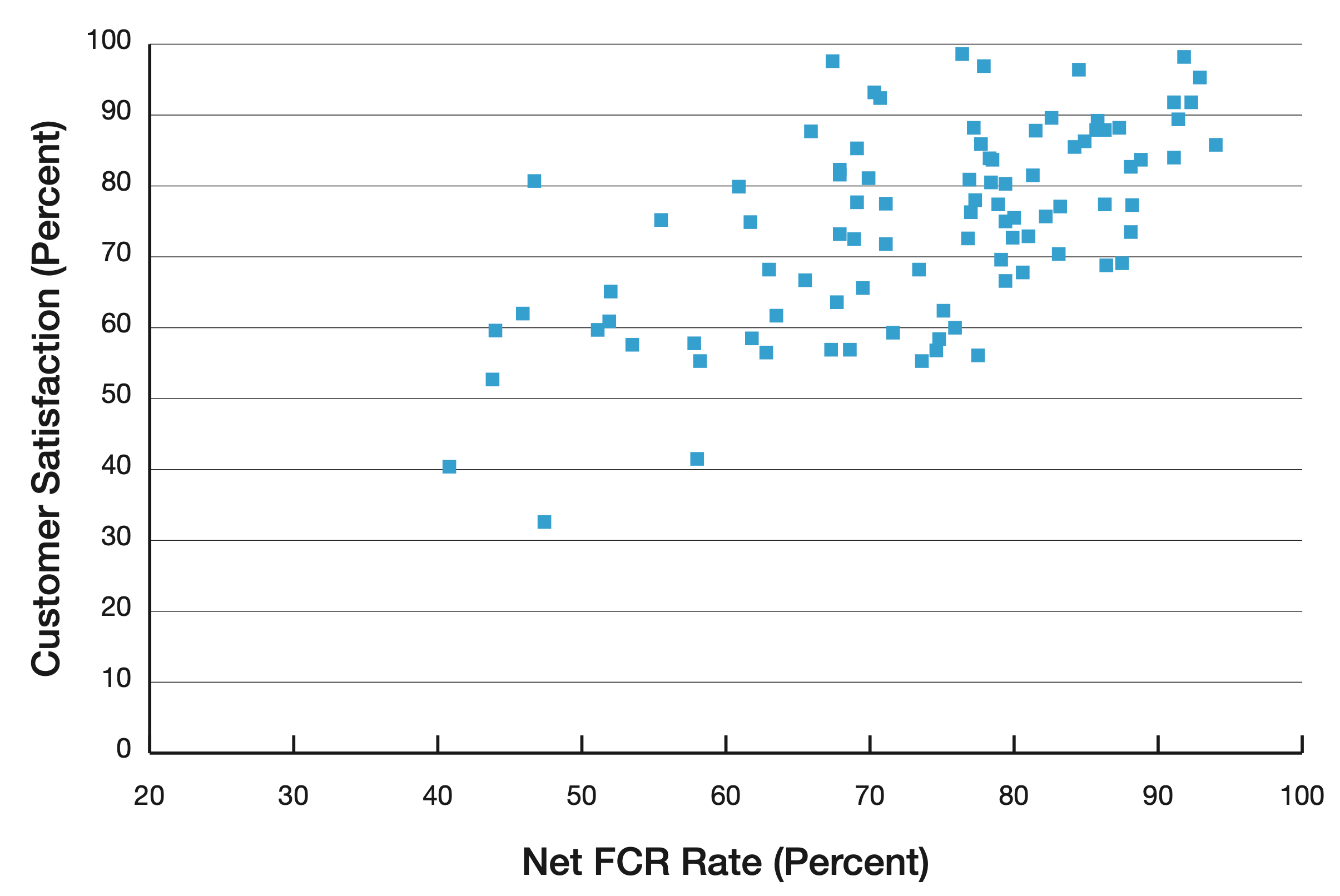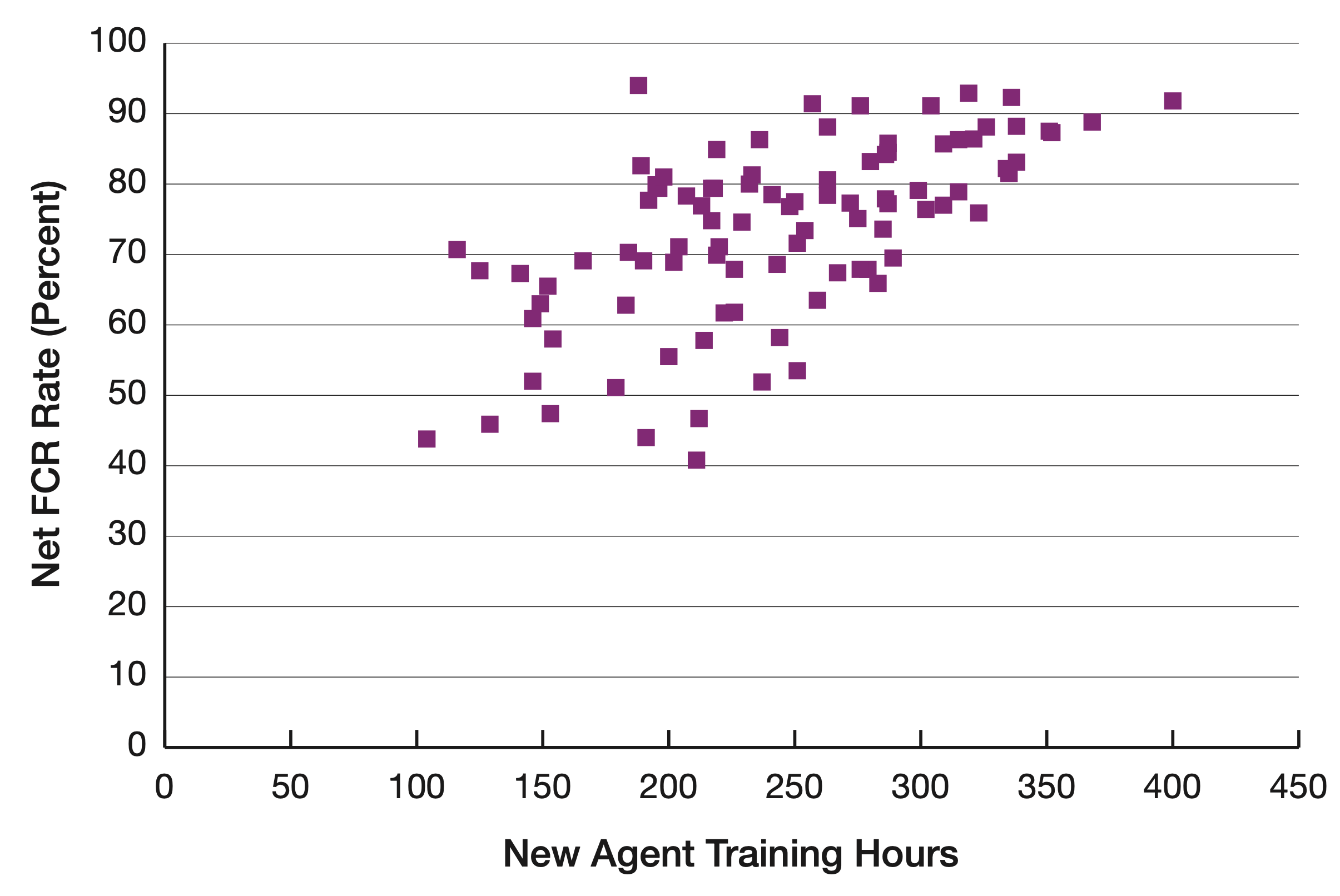Prefer headphones? Take a listen to this post on the Snackable CX podcast.
First Contact Resolution (FCR)—how often a customer has their question or issue resolved in a single interaction with a business—is one of the most important key performance indicators (KPIs) a business can measure.
According to research conducted by SQM, for every 1% increase in FCR, a business can expect to:
- Reduce call center operating costs by 1%, saving you money.
- Increase customer satisfaction (CSAT) by 1%, creating loyal customers.
- Increase employee satisfaction (ESAT) by 1-5%, fostering engaged workers.
- Increase Net Promoter Score (NPS) by 1.4 points, promoting and generating more business.
With all these benefits, you’d think that first contact resolution would get a little more airtime in executive meetings. Unfortunately, talk of improvement is often siloed to customer service departments or call center management teams.
If you want to sustainably increase your first contact resolution rate, you need to constantly address FCR at every level of your business — starting in the c-suite and ending with individual customer service agents. Here’s a five-step, top-down approach to start improving your FCR today.
Step 1: Establish a business-wide understanding of first contact resolution.
The first step in improving FCR is to emphasize its importance across your entire business. After all, without executive or management buy-in, motivating the rest of your business to improve FCR will prove difficult. Make it a top priority to communicate the importance of FCR to each department—specifically what it is, how it’s measured, and how each team can ultimately help improve FCR rates and the customer experience.
For example, you could communicate to the product team that they should proactively think through answers to questions a customer might have about the product. They would then communicate those questions and answers to the customer service department so customer service and sales reps can be better equipped to handle customer calls.
Similarly, marketing teams could also use those questions and answers to create helpful content that both drives new customers and answers commonly asked questions, heading off calls before they even reach the customer service department.
When you turn first contact resolution into a team sport, everyone can actively work toward improving it. Establish the importance of FCR for your business, then encourage your departments to think through how they can uniquely address and improve it.
Step 2: Remove FCR hurdles for your customer service agents.
The second step you need to take to improve FCR is to review and remove any internal procedures or policies that result in your customer service agents having to escalate calls, transfer them to other departments, or place the burden back on the customer.
FCR rates flounder when policies and procedures require additional attention—whether from someone inside or outside the customer service department. When agents have more authority to resolve problems upfront, businesses can reduce call transfers and dragging customers through procedural hoops.
Examples of these procedures include:
- Changing contact or billing information
- Handling returns and issuing refunds
- Applying discounts or promotional offers
- Reviewing and changing billing cycles
The Harvard Business Review found that reducing the amount of work or steps—either real or perceived—a customer has to take to solve their problem, the higher their satisfaction, loyalty, and chance of doing business with you again in the future.
Your customer service representatives need to have as much authority and autonomy as possible to create a helpful, stress-free experience for your customers the first time around.
Step 3: Provide FCR training for your customer service agents.
A study conducted by MetricNet discovered a direct correlation between the number of training hours a customer service agent receives and first contact resolution percentage. More training translates into higher FCR percentages, higher customer satisfaction, and, ultimately, lower customer service costs and higher returns for your business.
 |
 |
Source: ThinkHDI
In its purest form, FCR training is all about equipping your customer service agents with the tools they need to efficiently handle calls and providing a space where both agents and management can evaluate and hone their skills.
Call recording is one of the simplest and most effective training tools available to both management and customer service agents. Not only do recordings provide a way for management teams to evaluate agent performance, but they can show agents exactly how they should (or shouldn’t) handle calls, answer questions, and overcome customer objections. As more calls are recorded over time and flagged as successful or unsuccessful in terms of FCR, managers can compile recorded calls and include them in onboarding and training for new or struggling agents.
Other ways you can approach first contact resolution training include:
- Create mentorship and coaching programs that pair inexperienced or struggling customer service agents with more experienced managers or agents.
- Standardize and distribute helpful scripts, responses, and software procedures to each customer service agent, then plan seminars that walk agents through best practices.
- Host bi-weekly or monthly sessions where agents can actively interact with each other and hone their skills.
The more time and resources you invest in equipping your service agents to improve FCR, the greater the return for your business.
Step 4: Deploy a callback solution to facilitate calmer, more productive calls.
The fourth step in improving FCR is to provide customers with the ability to schedule a callback. Callback solutions allow customers to hang up the phone while they wait in line, removing the frustration they’d have from being forced to stand by the phone and wait on hold. One study shows that just under 60% of consumers are only willing to wait on hold for five minutes or less, and 32% of customers believe they shouldn’t have to be put on hold at all.
When you eliminate hold times, callers are generally happier and easy to work with. A study by Clutch found that 57% of customers rank long hold times as the most frustrating part of interacting with a business over the phone.
And that frustration doesn’t simply disappear as soon as the customer gets in touch with a customer service representative. Instead, long hold times lead to customers focusing their frustration on your service agents—extending the length of the call, lowering chances of FCR, and impacting employee morale.
With Mindful, you can give customers free time instead of hold time, allowing them either receive a call from the next available agent, or schedule a time that’s better for them. Plus, they can do this through Mindful’s IVR phone menu, your website via Digital Callback, or even by text.
Callbacks both free up the customer to get back to their day (increasing customer satisfaction, reducing average seconds to answer, lowering toll costs) while also delivering a calmer customer to the interaction, which drastically reduces handle times and increases FCR. When the customer doesn’t feel the need to vent to the agent, the call is shorter, the agent can address the issues faster, and is more willing to go the extra mile to deliver a comprehensive experience.
Step 5: Deploy a call scheduling solution to capture customer and call context.
The more information you have about a caller—who they are and why they’re calling—before calling them back, the easier it is to create a personal connection and resolve their issue on the first attempt. That’s why using call scheduling is so important: Not only does it help eliminate unnecessary hold times, but it gives you opportunity to gather information about your caller so you can go into the call with solution in hand.
One way to accomplish this is by setting up an IVR workflow the caller must navigate before scheduling a callback. Set up your IVR to ask why a customer is calling or which department they want to get in touch with.
If a customer indicates through the IVR that they have a question about billing, for example, but decide to schedule a callback instead of wait in the digital queue, their callback can be automatically routed to the billing department to avoid unnecessary call transfers.
You can also collect caller information and intent via your website by using Mindful’s callback widget. Collect details about the call (like what department they need, or what issue they’re having) online so that the right agent can get the call off the bat. Then you can use automated messaging to verify the callback time, customer contact information, and reason for the call to give your customer service reps a head start in addressing the issue.
Step 6: Use post-interaction surveys to create a feedback loop between customers and business managers.
With one in three customers stating they would take their business elsewhere after a single poor customer experience, you can’t afford to ignore a customer’s perception or sentiment towards your customer service department. And because customer satisfaction and FCR are so intertwined, it’s critical to gather input from your customers to measure your customer service performance so you can make adjustments when necessary.
The best way to measure FCR from the customer’s perspective is to send them a survey immediately after they interact with your customer service department. This can take the form of a customer staying on the line and completing a survey through the IVR, or Mindful’s Notifications feature can automatically text a survey link to a customer immediately following their interaction with a service agent.
Three core questions you should incorporate in each of your surveys include:
- Was your question or issue resolved during this interaction?
- How satisfied were you with the service you received today?
- How likely are you to recommend our product or service?
Once you’ve collected customer surveys, your executive and management teams should make a habit of reviewing them on a regular basis. This helps to ensure your customer service department is performing well and highlight any problem areas that might arise in terms of customer satisfaction and FCR.
Summing up: First contact resolution is the ultimate convenience for customers.
In a study by PWC, 80% of U.S. polled consumers reported “speed, convenience, knowledgeable help, and friendly service” as the most important elements of a positive customer experience. Not surprisingly, each of these elements ties directly into how well your business maintains a high first contact resolution rate across your communication channels.
As the originators of callback technology, we built Mindful to help businesses put customers in control of their communication and create excellent customer experiences. Learn more about how Mindful can help you boost your FCR rate and customer satisfaction in a matter of days.





